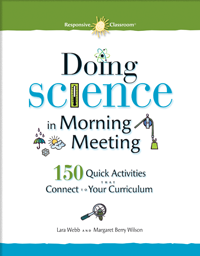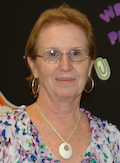Science in Morning Meeting: 150 Activities Connecting to Curriculum
Doing Science in Morning Meeting: 150 Quick Activities that Connect to Your Curriculum
By Lara Webb and Margaret Berry Wilson
(Northeast Foundation for Children, Inc., 2013 – Learn more)
Reviewed by Linda Biondi
I felt as if I had found a goldmine this summer when I opened up the book Doing Science in Morning Meeting by Lara Webb and Margaret Berry Wilson.
I have to admit it. One of my favorite parts of the day is when the bell rings, school begins, and we meet for Morning Meeting. Morning Meeting is the perfect way to begin the day. Imagine a classroom where children have fun working together as a classroom community and active learning goes on from the moment the students enter the classroom until they leave. That’s what the Responsive Classroom model looks like.
 Now take a minute and think about your early experiences with science. Was it collecting and categorizing rocks as a young child and hiding them under your bed? Or was it sitting as still as a statue, watching a butterfly flutter from flower to flower gathering nectar? Or was it looking out the window in the morning, finding your snow creation gone and wondering “where do snowmen go at night?”
Now take a minute and think about your early experiences with science. Was it collecting and categorizing rocks as a young child and hiding them under your bed? Or was it sitting as still as a statue, watching a butterfly flutter from flower to flower gathering nectar? Or was it looking out the window in the morning, finding your snow creation gone and wondering “where do snowmen go at night?”
Webb and Wilson’s new book, Doing Science in Morning Meeting, encourages teachers to integrate science into the daily schedule instead of “pigeonholing” the subject into a specified time slot. Although the book is designed around the Morning Meeting structures, teachers will find the format of the book easy to adapt to a science lesson, to Closing Circle (end of day) or to other areas of the curriculum.
What’s inside
The format of the book easy to use and teachers can locate activities by title, grade level, Morning Meeting component, science content or connection to the NGSS 2012 Framework for K-12 Science Education. In addition, each activity includes disciplinary core ideas, science and engineering practices, materials needed and specific vocabulary addressed in the lesson. All activities are quick, taking five to 10 minutes to complete, and require very limited materials or preparation.
Although the book is divided by grade levels, most of the activities can be modified to any grade level. For example, “Shine on Me” is a first grade activity to reinforce the Earth’s place in the universe. In this activity, one student is the Sun and the other student is the Earth. The Sun stands in front of the Earth, holds the flashlight, and shines it on Earth. Quoting from the book:
1. Earth begins with left shoulder facing the sun. Each person says, “Good morning, ____________” to the other.
2. Each turns so that he is face-to-face with the sun. Each person says, “Happy noontime, __________”.
3. Earth turns with the right shoulder facing the sun. Each person says, “Good evening, ______________”.
4. Finally, Earth turns so that his back is to the sun. Each person says “Good night, _________”.
5. While the Earth and sun are greeting each other, the other students act as stars in the sky, using their fingers to “sparkle’ light toward the two greeters.
6. Finally, make sure the greeting goes around the circle so that each child has a chance to the sun or the Earth once.
Although the sample activity is directed towards students in a lower elementary level classroom, it can easily be adapted to any grade level by increasing the science knowledge involved. It draws on a high level of student involvement, movement, and peer interaction. Instead of providing scripted lessons for teachers, the book empowers the teacher to adapt the lessons to meet the needs of the students. To me, that’s part of the magic of the book. It solidifies what are best teaching practices.
Cross-curricular ideas
Each time I looked through the book for ideas to apply in my fourth grade classroom, I immediately found another one to add to my repertoire. The book targets science skills and concepts, but all subject areas are equally represented in the presentation of the lessons. For example, in a second grade lesson about the ocean ecosystem, the authors also included a language arts lesson, “A Poem for Two Voices,” which is consistent with the Common Core Standards for Speaking and Listening. This particular lesson is easily adaptable to use with other grade levels by including more complex vocabulary or adding physical movement to the choral reading. Quoting from the book:
Glorious Ocean
Glorious ocean vast and wide,
No two words can describe
Deep Wide
Blue Green
Warm Cold
Dark Light
Stormy Calm
Glorious ocean vast and wide,
So many creatures live inside
Sharks Jellyfish
Whales Plankton
Octopi Shrimp
Squid Sea urchin
Dolphins Crabs
Glorious ocean vast and wide,
Waves crash as they bring in the tide.
Glorious ocean vast and wide.
Glorious ocean vast and wide.
Glorious ocean. Glorious ocean.
Glorious. Glorious.
The class is divided into two groups with Group One reading the left column of the poem and Group Two reading the right hand side. For the non- italicized lines, the groups read their lines one at a time, with Group One going first. For italicized lines, both groups read their lines simultaneously. Suggestions follow each activity such as having the students use movements to perform the key words and having students rewrite the poem using new stanzas and refrains in the activity above.
A great appendix!
The authors seem to leave no stone unturned. The appendix of the book is like opening a pirate’s treasure chest and finding wealth beyond your imagination. First of all, each grade level lesson documents the Morning Meeting component, the science content covered, and the 2012 Framework for K-12 Science Education. In addition, the authors designate a section of the appendix to address which Speaking and Listening Standards are being used. Lastly, there is an excellent list of selected children’s books that support science learning by grade level and area of science it addresses.
Whether you are a science expert, science aficionado, or new to teaching science, this book is a “keeper.” Doing Science in Morning Meeting is a must-have resource for novice teachers, veteran teachers, elementary teachers, middle school teachers and science/STEM elementary coaches. Ms. Webb and Ms. Wilson invite you to “use, adapt, invent, and enjoy” their book, as you “probe questions, model scientific phenomena, and experiment, remember to have fun, embrace mistakes as opportunities for learning, and keep a curious and open mind.”
Linda Biondi is a fourth grade teacher at Pond Road Middle School in Robbinsville, NJ, and a recipient of several educational grants that infuse a literacy enriched curriculum, along with an understanding of individual learning styles to help students understand bias and patterns of discrimination. She is a Teacher Consultant with the National Writing Project and a participant on the NJ Department of Education Teacher Advisory Panel.


































